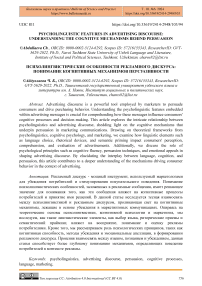Psycholinguistic features in advertising discourse: understanding the cognitive
Автор: Abdullaeva Ch.
Журнал: Бюллетень науки и практики @bulletennauki
Рубрика: Филологические науки
Статья в выпуске: 6 т.10, 2024 года.
Бесплатный доступ
Advertising discourse is a powerful tool employed by marketers to persuade consumers and drive purchasing behavior. Understanding the psycholinguistic features embedded within advertising messages is crucial for comprehending how these messages influence consumers' cognitive processes and decision-making. This article explores the intricate relationship between psycholinguistics and advertising discourse, shedding light on the cognitive mechanisms that underpin persuasion in marketing communications. Drawing on theoretical frameworks from psycholinguistics, cognitive psychology, and marketing, we examine how linguistic elements such as language choice, rhetorical devices, and semantic priming impact consumers' perception, comprehension, and evaluation of advertisements. Additionally, we discuss the role of psychological principles such as cognitive fluency, persuasion techniques, and emotional appeals in shaping advertising discourse. By elucidating the interplay between language, cognition, and persuasion, this article contributes to a deeper understanding of the mechanisms driving consumer behavior in the context of advertising.
Psycholinguistics, advertising discourse, persuasion, cognitive processes, language, marketing
Короткий адрес: https://sciup.org/14130221
IDR: 14130221 | УДК: 811 | DOI: 10.33619/2414-2948/103/94
Текст научной статьи Psycholinguistic features in advertising discourse: understanding the cognitive
Бюллетень науки и практики / Bulletin of Science and Practice
UDC 811
Advertising discourse serves as a conduit for communication between marketers and consumers, with the ultimate goal of influencing consumer behavior. At its core, advertising is a persuasive endeavor, aiming to capture attention, evoke emotions, and compel action. However, the effectiveness of advertising messages is not solely dependent on their visual and auditory elements but also on their linguistic features [5]. Psycholinguistics, the interdisciplinary field that examines the relationship between language and cognition, offers valuable insights into how language shapes human thought, perception, and behavior [2]. By analyzing the psycholinguistic features embedded within advertising discourse, researchers can uncover the cognitive mechanisms underlying persuasion and consumer decision-making.
In this article, we delve into the nexus of psycholinguistics and advertising discourse, exploring the ways in which linguistic elements interact with cognitive processes to influence consumers' responses to advertisements. We begin by providing an overview of key theoretical concepts from psycholinguistics and cognitive psychology relevant to understanding advertising persuasion. Subsequently, we examine specific psycholinguistic features commonly employed in advertising, such as language choice, rhetorical devices, and semantic priming [10]. We then discuss the role of psychological principles, including cognitive fluency, persuasion techniques, and emotional appeals, in shaping the effectiveness of advertising discourse [3]. Finally, we highlight implications for marketers and advertisers seeking to optimize the impact of their communication strategies.
Psycholinguistics, as a subfield of both psychology and linguistics, investigates how language is processed and represented in the human mind [7]. Central to psycholinguistic theory is the idea that language comprehension involves a complex interplay of cognitive processes, including perception, attention, memory, and inference [9]. According to this perspective, linguistic stimuli are not passively received but actively interpreted and integrated with existing knowledge structures in the mind.
Cognitive psychology provides further insights into the mechanisms underlying human cognition, emphasizing the role of mental representations, schemas, and heuristics in information processing. From a cognitive perspective, individuals engage in a variety of cognitive activities when exposed to advertising messages, including attentional allocation, semantic processing, and decision-making [1]. Moreover, cognitive psychology emphasizes the importance of automatic processes and heuristics in guiding behavior, suggesting that consumers often rely on mental shortcuts and intuitive judgments when evaluating advertisements.
Let's delve deeper into the analysis of psycholinguistic features in advertising discourse with some examples:
Psycholinguistic Features in Advertising Discourse. Language Choice: One of the fundamental decisions in advertising discourse is the selection of language that resonates with the target audience. Linguistic variations such as vocabulary choice, tone, and register can significantly impact consumers' perceptions of an advertisement [4]. For example, advertisements targeting.
Consider a cosmetics advertisement targeting young adults. The language used in the ad might include trendy slang words and colloquial expressions to appeal to the target demographic's sense of identity and belonging. For instance, instead of simply stating
"Our product makes your skin glow, "the ad might say "Get that lit glow with our new skincare line."
By incorporating language that resonates with the target audience's linguistic preferences, the advertisement establishes a connection with consumers, making the message more relatable and persuasive. This demonstrates how language choice can influence consumers' perceptions and attitudes towards the advertised product.
Rhetorical Devices: Advertising frequently employs rhetorical devices such as metaphor, simile, hyperbole, and irony to convey persuasive messages. These devices serve to enhance the aesthetic appeal of advertisements, capture attention, and evoke emotional responses.
An advertisement for a luxury car might use metaphorical language to evoke feelings of power and status. For instance, the ad could describe the car as
"a sleek panther prowling through the urban jungle, "
invoking imagery associated with strength, agility, and sophistication.
By employing metaphors, the advertisement not only captures attention but also conveys abstract concepts such as luxury and performance in a vivid and memorable manner. Rhetorical devices like metaphor enhance the aesthetic appeal of the advertisement and evoke emotional responses, thereby increasing its persuasive impact.
Semantic Priming: Semantic priming refers to the phenomenon whereby exposure to a stimulus influences the processing of subsequent related stimuli. In advertising, semantic priming is often utilized to activate associations and schemas linked to a product or brand [8].
A fast-food advertisement featuring images of juicy burgers and crispy fries might be accompanied by phrases such as:
s"atisfy your cravings "or i"ndulge in mouthwatering goodness. "
These linguistic cues prime consumers to associate the advertised products with feelings of satisfaction and pleasure.
Through semantic priming, the advertisement activates pre-existing associations and schemas related to food enjoyment and indulgence [2]. By strategically pairing linguistic cues with sensory-rich visuals, the advertisement enhances consumers' perceptions of the products' taste and appeal, thereby increasing their likelihood of purchase.
Psychological Principles in Advertising Discourse:
Cognitive Fluency: Cognitive fluency refers to the ease with which information is processed and understood. Advertisements that are linguistically fluent, concise, and coherent are more likely to be perceived positively by consumers [5].
An advertisement for a household cleaning product uses simple, straightforward language to highlight its effectiveness in removing tough stains. The ad emphasizes phrases like:
"powerful cleaning action"and "guaranteed results in seconds " to convey the product's ease of use and immediate benefits.
By ensuring cognitive fluency, the advertisement makes it easier for consumers to process and understand the message quickly. This enhances consumers' confidence in the product's efficacy and fosters positive attitudes towards the advertised brand.
Persuasion Techniques: Advertising discourse relies on a variety of persuasion techniques to influence consumer attitudes and behavior [8].
These techniques include: Emotional Appeals and Implications for Marketers (Identifying Target Emotions, Creating Authentic Connections, Telling Compelling Stories, Maintaining Consistency, Measuring Emotional Impact) (Figure).
Emotional Appeals

Persuasion Techniques

Implications for Marketers
-
• Identifying Target Emotions
-
• Creating Authentic Connections
-
• Telling Compelling Stories
• Maintaining Consistency
• Measuring Emotional Impact

Figure.
Emotional Appeals: Emotions play a crucial role in advertising persuasion, as they can evoke strong affective responses and motivate consumer action.
A charitable organization's advertisement seeking donations for children in need might feature heart-wrenching imagery of impoverished conditions accompanied by emotionally charged language such as
"help save a child's life "or "make a difference today."
By eliciting strong emotional responses such as empathy and compassion, the advertisement motivates viewers to take action and support the cause. Emotional appeals tap into consumers' altruistic impulses and foster a sense of moral obligation, increasing the likelihood of engagement and donation.
Coming to Implications for Marketers, Understanding the power of emotional appeals can guide marketers in crafting advertisements that resonate deeply with consumers and drive engagement and loyalty [6]. Some implications include:
-
1 . Identifying Target Emotions: Marketers should conduct thorough market research to identify the emotions most relevant to their target audience and product category. Understanding which emotions are likely to resonate with consumers can inform the development of more impactful emotional appeals.
-
2 . Creating Authentic Connections: Authenticity is key when leveraging emotional appeals in advertising. Marketers should strive to create genuine and relatable narratives that authentically connect with consumers' experiences, values, and aspirations. This requires understanding the target audience's demographics, psychographics, and cultural nuances.
-
3 . Telling Compelling Stories: Emotional appeals are often conveyed through storytelling, allowing marketers to create narratives that captivate and move audiences. Marketers should craft narratives that evoke emotions, spark imagination, and inspire action. Compelling storytelling can leave a lasting impression and foster strong emotional connections with the brand.
-
4 . Maintaining Consistency: Emotional appeals should align with the brand's overall identity, values, and positioning. Consistency in messaging and tone ensures that emotional appeals resonate authentically with consumers and reinforce brand perceptions over time. Marketers should integrate emotional appeals seamlessly into their broader marketing strategy to maintain coherence and relevance.
-
5 . Measuring Emotional Impact: Marketers should utilize metrics and analytics tools to assess the emotional impact of their advertising campaigns. Tracking consumer sentiment, engagement
levels, and brand affinity can provide valuable insights into the effectiveness of emotional appeals and inform future campaign optimizations. Additionally, qualitative research methods such as focus groups or surveys can provide deeper insights into consumers' emotional responses to advertisements [3].
In each of above-mentioned examples, the psycholinguistic features embedded within advertising discourse play a crucial role in shaping consumers' perceptions, attitudes, and behaviors. By strategically leveraging language, rhetorical devices, semantic priming, cognitive fluency, and emotional appeals, advertisers can create more compelling and persuasive advertisements that resonate with their target audience's cognitive and emotional processes [4].
Thus, understanding the psycholinguistic features embedded within advertising discourse can inform marketers' strategies for creating more effective and persuasive advertisements.
In conclusion, the study of psycholinguistic features in advertising discourse offers valuable insights into the cognitive mechanisms underlying persuasion and consumer behavior. By examining the interplay between language, cognition, and persuasion, researchers can gain a deeper understanding of how advertising messages influence consumers' perceptions, attitudes, and purchasing decisions. Moreover, insights from psycholinguistics can inform marketers' strategies for creating more compelling and impactful advertisements. Ultimately, by leveraging the principles of psycholinguistics, advertisers can enhance the effectiveness of their communication efforts and better connect with their target audience.
Список литературы Psycholinguistic features in advertising discourse: understanding the cognitive
- Cialdini R. B. Influence: the psychology of persuasion, revised edition // New York: William Morrow. 2006.
- Petty R. E., Cacioppo J. T.Communication and persuasion: Central and peripheral routes to attitude change. Springer Science & Business Media, 2012.
- Berger J. Contagious: How to build word of mouth in the digital age. Simon and Schuster, 2013.
- Kahneman D. et al. Thinking, fast and slow: Farrar //Straus and Giroux. 2011. V. 1.
- Heath C., Heath D. Made to stick: Why some ideas survive and others die. Random House, 2007.
- Eagly A. H., Chaiken S. The psychology of attitudes. Harcourt brace Jovanovich college publishers, 1993.
- Andrews J. C., Shimp T. A. Advertising, promotion, and other aspects of integrated marketing communications. Cengage Learning, 2018.
- Solomon M. R. Consumer behavior: Buying, having, and being. Pearson, 2020.
- Eagly A. H., Chaiken S. The psychology of attitudes. Harcourt brace Jovanovich college publishers, 1993.
- Smith R. E., Swinyard W. R. Information response models: An integrated approach // Journal of Marketing. 1982. V. 46. №1. P. 81-93. DOI: 10.1177/002224298204600108


